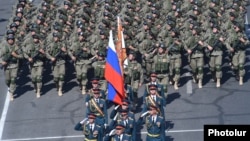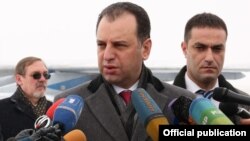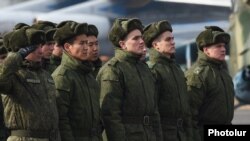Russian military presence in Armenia remains a “very important” element of the country’s national security strategy, Defense Minister Vigen Sargsian said in an interview published on Wednesday.
Sargsian also told the RIA Novosti that Armenia stands ready to further deepen its broader military cooperation with Russia.
“Russia is our strategic ally,” he said. “This is how we view the ongoing cooperation with Russia in terms of training of military personnel, in the military-technical sphere and in the military-political dialogue. We think that it’s an inseparable complex. We are open to and ready for a further intensification of this dialogue.”
As part of that alliance, up to 5,000 Russian troops have been stationed in Armenia ever since the Soviet breakup. Sargsian called the Russian military base headquartered in Gyumri “an important factor of deterrence.”
“We consider its presence in Armenia to be a very important component of the security system of our country,” he added.
The Russian base also has hundreds of tanks, armored vehicles, and artillery systems as well as around two dozen MiG-29 fighter jets. Moscow has bolstered it with helicopter gunships and other military hardware since a 2010 Russian-Armenian agreement extended its basing rights in Armenia to 2044.
Sargsian did not deny reports that the Russian military has also deployed its newly developed Nebo-M radar systems to the Gyumri base recently.
Armenian leaders have long said that Armenia hosts Russian troops on its territory primarily because of a perceived security threat from Turkey, rather than Azerbaijan. From Yerevan’s perspective, the Russian military presence precludes Turkey’s direct military intervention on Azerbaijan’s side in the Nagorno-Karabakh conflict.
Some of the Russian troops in Armenia and an Armenian army unit make up a Russian-Armenian military force set up in 2000. Sargsian and Russian Defense Minister Sergey Shoygu signed an agreement in November last year on reinforcing “the united group of troops.” It is still not clear whether the joint contingent will be enlarged as a result.
The military alliance with Russia has also enabled Armenia to receive Russian weapons at discounted prices or even for free. Sargsian emphasized the fact that Yerevan is using a $200 million loan extended by Moscow in 2015 for buying various Russian weapons at Russia’s “internal prices.” Some of that military hardware has already been delivered to Armenia ahead of schedule, he said without elaborating.
“We will continue the dialogue with the Russian side on the possibility of acquiring weapons in the Russian market,” Sargsian told RIA Novosti.
The $200 million loan reportedly does not cover Russian state-of-the-art Iskander missiles that were supplied to the Armenian army and first demonstrated by it at a military parade in Yerevan in September. Sargsian refused to disclose financial terms of that acquisition.
The 41-year-old minister insisted that the missile systems belong to Armenia and are operated by Armenian army officers. He described them as a “weapon of deterrence,” in a clear reference to the Karabakh dispute.
President Serzh Sarkisian likewise said in November that the Iskander missiles are an “antidote” against Azerbaijan’s possible attempts to achieve a military solution to the dispute.
With a firing range of at least 300 kilometers, Iskander is known for their precision and ability to overcome modern missile defense shields.







Facebook Forum